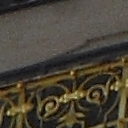I'm training an autoencoder, that does not downsample images but processes them in the same size. For example, a 256x256 input will always be processed at 256x256 resolution, only the channels increase deeper in the network. This design is due to the next stage for which the model will be used. L2 regularization on activations is added since this is essentially a sparse autoencoder.
However, I get some strange artifacts in the corners when the model converges:
The left image is the input, the image on the right is the output. The artifacts can be seen on the top-left and top-right corners of the output image.
Can someone explain what causes these artifacts, and how they can be fixed?


